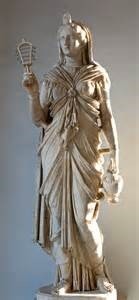Current research reveals that some early Christians revered God in female form. Let’s take a look at the evidence, which starts with an overview of the context out of which Christianity emerged.
Christianity emerged in the Graeco-Roman era when people worshipped many gods and goddesses – Zeus, Athena, Dionysos, Apollo, the Great Mother, Sylvanus; this is referred to as polytheism. Christianity also emerged from Judaism, whose heritage reflects interaction with worshippers of Baal and Asherah and the honoring of Sophia/Wisdom.
In these pre-industrial and agrarian cultures, people saw immediate links between Nature and female attributes: the earth, with its caves like wombs and mountains like breasts, provided food and sustenance; the moon with its 28-day cycle paralleled the life-giving cycle of women; rivers and springs reflected the female’s life-sustaining flow of milk, amniotic fluid and blood. While we moderns have lost some of these connections, they would have been obvious to our ancestors. We might say that, from a psychological perspective, ancient peoples seemed to need a female figure of worship.
As many Roman Catholics and Eastern Orthodox believers know, Mary the mother of Jesus became a very popular object of adoration over time (and still is). Mary was not only revered because she bore Jesus, the Son of God, but was worshipped in her own right by some ancient groups. It was not a stretch for people to link their familiar goddesses with stories of Jesus’ mother and to feel they could call on her for help.
At Philippi in northern Greece, a city with a crucial Christian heritage (as we saw in the post on St. Paul and women), an altar to “Queen Isis,” with a dove and cross carved into it, was found near an inscription to Jesus bearing a reference to Mary. This third-century altar had been moved to the city gate in antiquity, and the inscription was dated to the fifth or sixth century. This suggests that the people of Philippi were appealing to Mary in the guise of the all-powerful Egyptian goddess Isis, along with Jesus, at this late date. 
Isis figures elsewhere as well. Roman writer Apuleius’s second-century novel, The Golden Ass, preserves the author’s devotion to Isis. Later, a fifth- or sixth-century Christian document, the Arabic Infancy Gospel, relates a parallel story of transformation, with Mary in the role of Isis. Chapter 17 of this work tells the tale of a girl whose leprosy was cured by Jesus’ bath water. The witnesses to the miracle declare, “There is no doubt that Joseph and Mary and this child are gods, not [human beings].”
Finally, a fourth-century Bishop, Epiphanius, in one treatise attacked the Collyridian sect, which was composed primarily of women and may have included the sacrificing of cakes to Mary, imitating rituals to Ceres or Artemis. Epiphanius elsewhere admonished readers that Mary was holy but not God and “was not given to us to worship.” This means that the practice was happening centuries after Jesus lived – and church leaders did not like it too much!
Even though “mainstream” Christianity and officials of the church disapproved of the worship of God in female form (the all-male doctrine of the Trinity that Christians are expected to revere – Father, Son and Holy Spirit – demonstrates this), it is vital to remember that Christianity was fluid and diverse for several centuries, and everyday worshippers continued to veer from official doctrine and revere Mary and other female deities. The trend in some Christian circles today to “resurrect” a goddess figure, therefore, is not new, and need not be viewed as strange or heretical. Retrieving the notion of a female deity can serve as a corrective to millennia of all-male worship in Christian denominations.
References
Abrahamsen, Valerie A. Goddess and God: A Holy Tension in the First Christian Centuries. Marco Polo Monographs 10. Warren Center, PA: Shangri-La Publications, 2006.
Abrahamsen, Valerie. “Human and Divine: The Marys in Early Christian Tradition,” in A Feminist Companion to Mariology, ed. Amy-Jill Levine with Maria Mayo Robbins (London and New York: T & T Clark International, 2005) 164-81.
Ackerman, Susan. “Asherah/Asherim,” in Meyers, Carol, Toni Craven and Ross S. Kraemer, eds., 508-11. Women in Scripture: A Dictionary of Named and Unnamed Women in the Hebrew Bible, the Apocryphal/Deuterocanonical Books, and the New Testament. Grand Rapids, MI, and Cambridge, England: William B. Eerdmans Publishing Company, 2000.
Gimbutas, Marija. The Civilization of the Goddess, ed. Joan Marler. San Francisco: HarperSan Francisco, 1991.
Gimbutas, Marija. The Language of the Goddess. San Francisco: Harper and Row, Publishers, 1989.
